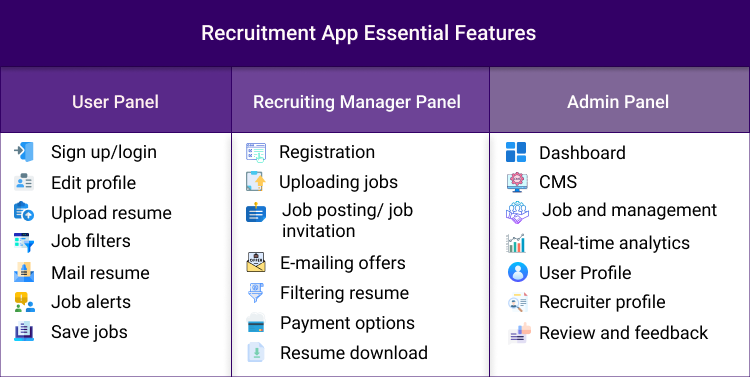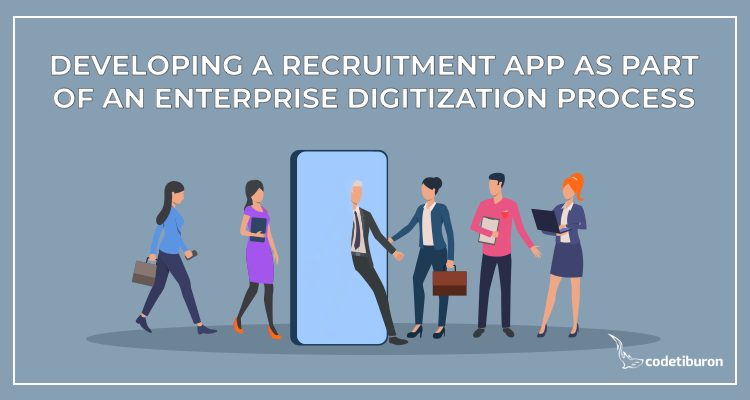Hiring in the post-pandemic brave new world is challenging.
What with the quarantine? Remote work? Candidates’ rights and new regulations? Testing? How to cope with applicants’ surge, secure the best talent, not to burn out, and provide excellent candidate experience?
The year 2020 has brought a significant advantage to organizations with advanced digital recruitment strategies. And those without have to act fast.
Alongside the use of ready-made tech solutions to automate, enhance, quicken, and improve the hiring process, companies devise custom applications for hiring.
Today we’ll explain the benefits of recruitment app development and give a quick guide to building a recruitment application.
Use the plan to jump to the question of your interest.
The state of recruitment tech market
HR tech interest is nearing an all-time high. Funding to the space swelled to a record $6.9B in 2019, and news mentions of ‘HR tech’ have more than doubled over the past 5 years.
Despite its vastness, the market of digital recruiting is fragmented and evolving. Together with the incumbents like Taleo Corporation (Oracle), SuccessFactors (SAP), ADP, Kronos, Accenture Plc., Ceridian HCM, Kenexa Corporation (IBM), Cognizant Technology Solutions, Halogen Software Inc., PeopleAdmin, and SumTotal Systems Inc. (focusing primarily on mergers and acquisitions), there are a variety of startups exploring new opportunities like:
- hiring tools;
- recruiting marketplaces & job search platforms;
- recruiting: contractors/freelancers.
On the other pole, recruiters and hiring agencies are struggling with disparate legacy systems and unstructured data, which challenge digital transformation. New recruitment trends like vertical talent pools and the gig economy require fresh solutions. Hiring during the pandemic asks for the next-gen efficiency.
The latest recruitment app development happens along these lines:
- Job boards & aggregators – optimize job listings to be seen by as many applicants as possible. Platforms like Indeed, CareerBuilder, Google for Jobs are essential as direct applicants make 48% of all hires.
- Testing & assessment – take care of quality. Companies that use these tools are 33% more satisfied with their hire. Examples: Hacker Rank, Pymetrics, Self Management Group.
- AI & automation. Tools like Idea, Textio, Zoom.ai help to screen and identify top talent. 66% of recruiters believe AI can drive significant value in HR.
- Applicant tracking systems make up the largest category, comprising Bullhorn, Greenhouse, SAP SuccessFactors, iCIMS, Jobvite, Lever, Smart Recruiters, Breezy HR, Jazz HR, Workable, Taleo, Workday. 90% of large companies use ATS.
- Video interviewing tools are increasingly popular. 63% of HR managers have conducted online interviews. Here belong ConveyIQ, HireVue, SparkHire, Wepow.
- Recruitment CRMs have become vital in HR. Tools like SmashFly, Yello, Avature, Talemetry, Beamery, Ascendify, Jibe help attract and engage candidates.
- Human capital management software is crucial now that the majority of employees work outside of the companies’ headquarters. Examples: BambooHR, Zenefits, Namely, Ultimate Software.
- Talent intelligence software (Linkedin Talent Insights, SeekOut, Eightfold AI, Humanintelligence, Loxo Recruitment Platform, Ideal, TurboHire, Plum, Fuel50, OutMatch, Censia, Skillate, Ascendify, Emsi, Ripplematch, Talent Science), being a subgroup of HCM software, it helps organizations find qualified active and passive candidates to increase their talent pipeline and fill open positions.
Read also: How to Build an Applicant Tracking System [Enterprise Use Case].
The most popular recruitment apps
As with any other app, developing an app for recruitment starts with learning from market leaders. Let’s take a look at some apps that shine in bringing recruiters and applicants closer together.
LinkedIn Recruiter
LinkedIn is a solid all-in-one job-search app, perfect for networking, sharing professional news, interacting with co-workers, and searching for jobs. 87% of talent (both active or passive) are open to new job opportunities. 77% of recruiters rely on LinkedIn Recruiter to find prospective job candidates.
The app helps minimize the efforts of collecting potential candidates’ information and profiles via its effective search tools and over 20 advanced filters. Moreover, recruiters can get unlimited access to the entire LinkedIn network of more than 690 million members, stay updated with prospective candidates, and enhance collaboration with other members of the team.
Yello
This talent acquisition platform enables the world’s leading brands to deliver personalized candidate experiences to every job seeker, resulting in quality hires and faster fills. The recruitment CRM is easy to use, enabling recruiters to collaborate with one another to attract and engage top talent. Key metrics provide meaningful insights that lead to more informed, data-driven decisions, all on budget. Some of its features include schedule automation, video interviewing, employee referrals, and integrations with ATSs and HRISs.
Approximately 100 of the Fortune 500 rely on Yello to power their hiring programs. The platform is used in 70+ countries and in 15+ different languages.
JobSnap
JobSnap is the hiring voice of Gen Z. The app’s core idea is no youth should be without job opportunities due to lack of experience or connections.
The app uses a swipe. But instead of profile cards, candidates and employers must upload 30-second videos to tell their stories. A good story can be an awesome equalizer, just as soft skills and creativity open many doors. The technology helps to bridge 3.5M jobs available in high-turnover industries and 5M young adults looking for work.
Oh well, the best are only a notch ahead of the rest: with a more robust architecture, better integrations, smarter technologies, or an innovative business model. What unites them though is the mobile-first approach. A mobile recruitment application has long become a must-have of any recruitment system.
The benefits of developing a recruitment mobile application
It would be hard to argue that mobile technology has transformed our lives. A mobile app for hiring is no exception. It provides beelines for recruiters and job seekers alike.
For candidates
- Convenience: job shopping at every point of the day.
- Speed: job alerts, search and one-click applying.
- Familiar environment: gen Y, making up 75% of workforce in 10-years’ time, is mobile-first.
- Excellent experience: a hassle-free end-to-end process.
For hiring managers
- Convenience and productivity: tools and fresh data access ‘on the go’.
- Instant feedback: reducing the waiting time of interactions.
- Reducing human errors: automation helps juggling multiple funnels.
- Enhancing engagement: notifications, one-click ad posting, IM-ing a candidate.
Essential features of a recruitment mobile application
A mobile application for recruitment is part of a complex HR system with different users performing different tasks to achieve their unique goals. Each category will have access to different functionality. In the case of the system CodeTiburon built, a mobile application was only developed for one category – the candidates. Hiring managers and admins, on the other hand, use a web application. This can vary across projects.
Here’s an idea of the functionality benefiting each category of users.
User panel essential features
- Sign up/login. First thing, users register via an email address or using social media credentials.
- Edit profile. Next, they can add preferences and areas of expertise for searching the most relevant jobs.
- Upload resume. Users create resumes directly from the app or upload a document.
- Job filters. Users filter by job types according to their preferences, like their areas of expertise, location, and years of experience.
- Mail resume. Users send resumes to the companies of their choice that advertise.
- Job alerts. Users get notified of the latest job updates or when a recruiter contacts them.
- Save jobs. Bookmarking or saving jobs for future purposes saves users a lot of time.
Recruiting manager panel essential features
- Registration. Hiring managers can use email or a mobile number for registration, or directly login via a social media account.
- Uploading jobs. Recruiters may upload jobs according to available vacancies. Admin can post jobs on the job portal, adding experience and expertise requirements for specific job postings.
- Job posting/job invitation. Hiring managers can post job offers or send invitations to eligible candidates. Later, they can also schedule an interview with the candidates for further process.
- E-mailing offers. Recruiters can also send job offers to eligible candidates according to the availability of vacancies.
- Filtering resume. Hiring managers can select or filter from thousands of resumes to find appropriate ones.
- Payment options. Recruiters manage or edit payment options and plans, add or delete services from the membership plans.
- Resume download. Besides searching or filtering the appropriate resume, recruiters can download the resume of eligible candidates to enable interview scheduling.
Read also: A Hiring Management System for Recruiting Agencies: Case Study.
Admin panel essential features
- Dashboard. The dashboard is essential for managing users, recruiters, and data of all customers.
- CMS. Admins can easily manage and edit all the content on the app with the help of a CMS.
- Job ad management. Admins manage all the job advertisements displayed or running on third-party websites and apps.
- Real-time analytics. Admins get insights into the reports related to jobs assigned, the total number of recruiters linked, jobs offered to users, and job search strategy.
- User profile. Admin verifies and manages user information and sends jobs to the user according to the preferences and filters selected.
- Recruiter profile. All the details related to a company’s core idea, address, license, and profiles of recruiters are managed by the admin, to exclude fake job listings.
- Review and feedback. Admin collects feedback and reviews from users and recruiters and uses them to improve the app.

Recruitment software technology stack
A technology stack is an essential part of developing any web or mobile application. It denotes a combination of programming languages and software underneath a development project in question.
Just like features, a technology stack for a recruitment app varies depending on objectives, strategy, activities, priorities, and existing capabilities.
The recruitment application CodeTiburon helped to develop for recruitment agencies had the following technology stack:

How much does it cost to develop a recruitment app?
Of course, you can’t just expect a fixed sum upfront whenever you ask how much for a recruitment app development. Simply because you aren’t buying it off the shelf.
Even if you’re thinking of building an existing recruitment app’s clone, a ballpark estimate may turn out way off the mark. It’s a matter of time before you discover that your enterprise has very different workflows and needs. No matter what you build, customization is always there.
Now let’s consider a fully customized recruiting app development.
- A recruitment app needs a database (or several), which involves a great deal of backend development. Discovering and building the app’s business logic is a huge effort unless you have a well-written specification already in place.
- Different users will require different functionality, so in fact, you end up with two or three apps (for candidates, hiring managers, admin, etc.).
- A recruitment app serves dual (or multiple) purposes: search and discovery, interaction, workflow, payment. The more complexity, the harder (and longer) to build, the more robust architecture you need from day one.
- The factors determining the cost are the app’s size, interfaces, platform(s), developers, 3rd-party APIs and SDKs.
So the estimates most often are wild guesses before you dig into the real product’s requirements. The only fact so far is that the hourly rates of Ukrainian developers are $35-50. Still, if you want to know how much developing a recruitment app MVP will cost, we’re here to help you calculate.
How much does it cost to build a recruitment app with CodeTiburon?

